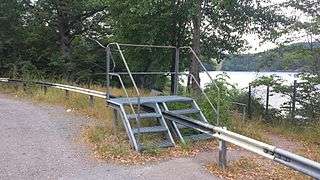Stile
A stile is a structure which provides people a passage through or over a fence or boundary via steps, ladders, or narrow gaps. Stiles are often built in rural areas along footpaths, fences, walls or hedges to prevent farm animals moving from one enclosure to another whilst allowing path users still to use the route.
Types

In the United Kingdom many stiles were built under legal compulsion (see Rights of way in the United Kingdom), however in the US there is not a standard design and there are a wide variety of types.
Recent changes in UK government policy towards farming has encouraged upland landowners to make access more available to the public, and this has seen an increase in the number of stiles and an improvement in their overall condition. However, on popular paths, stiles are increasingly replaced by gates or kissing gates or, where the field is arable, the stile removed.
Stiles also sometimes have a 'dog latch' or 'dog gate' to the side of them, which can be lifted to enable a dog to get through (see pictures below).
There is a British Standard that includes stiles BS5709:2006 Gaps Gates & Stiles (ISBN 0 580 48107 7). It says that "new structures shall not be stiles unless exceptional circumstances require them."

An alternative form of stile is a squeeze stile, which is commonly used where footpaths cross dry stone walls in England. With this type of stile there is a vertical gap in the wall, usually no more than 25 centimetres (9.8 in) wide, and often with stone pillars on either side to protect the structure of the wall. The gap must be narrow enough to prevent livestock getting through.
In popular culture
- In John Bunyan's allegorical novel The Pilgrim's Progress, there is a stile going into a meadow, the path across which leads to Doubting Castle, the home of Giant Despair.
- Stiles are mentioned frequently in Charlotte Brontë's novel Jane Eyre.
- In Piers Anthony's Apprentice Adept series, the main character is named Stile, with explicit reference to the physical structure.
- In Mark Twain's The Adventures of Huckleberry Finn, chapter 32 there is a stile made out of logs sawed off and upended in steps of unequal length.
- In J.K Rowling's Harry Potter series, in The Goblet of Fire chapter 27 Harry, Ron and Hermione meet Sirius Black by a stile near Hogsmeade Village.
- In John Barth's short story "Ambrose His Mark," the titular character's father, grandfather, and uncle Konrad travel "over stile and under trestle" in search of bees to make honey.
Gallery
 Ladder stile in Snowdonia
Ladder stile in Snowdonia Ranaghan Westmeath Mass-path Stile
Ranaghan Westmeath Mass-path Stile
 Stile with dog gate
Stile with dog gate- Low-level stile
 A step stile in the Lake District National Park
A step stile in the Lake District National Park Modern roadside stile in Sweden.
Modern roadside stile in Sweden. A wooden stile
A wooden stile
See also
External links
| Wikimedia Commons has media related to Stiles. |
| Look up stile in Wiktionary, the free dictionary. |
